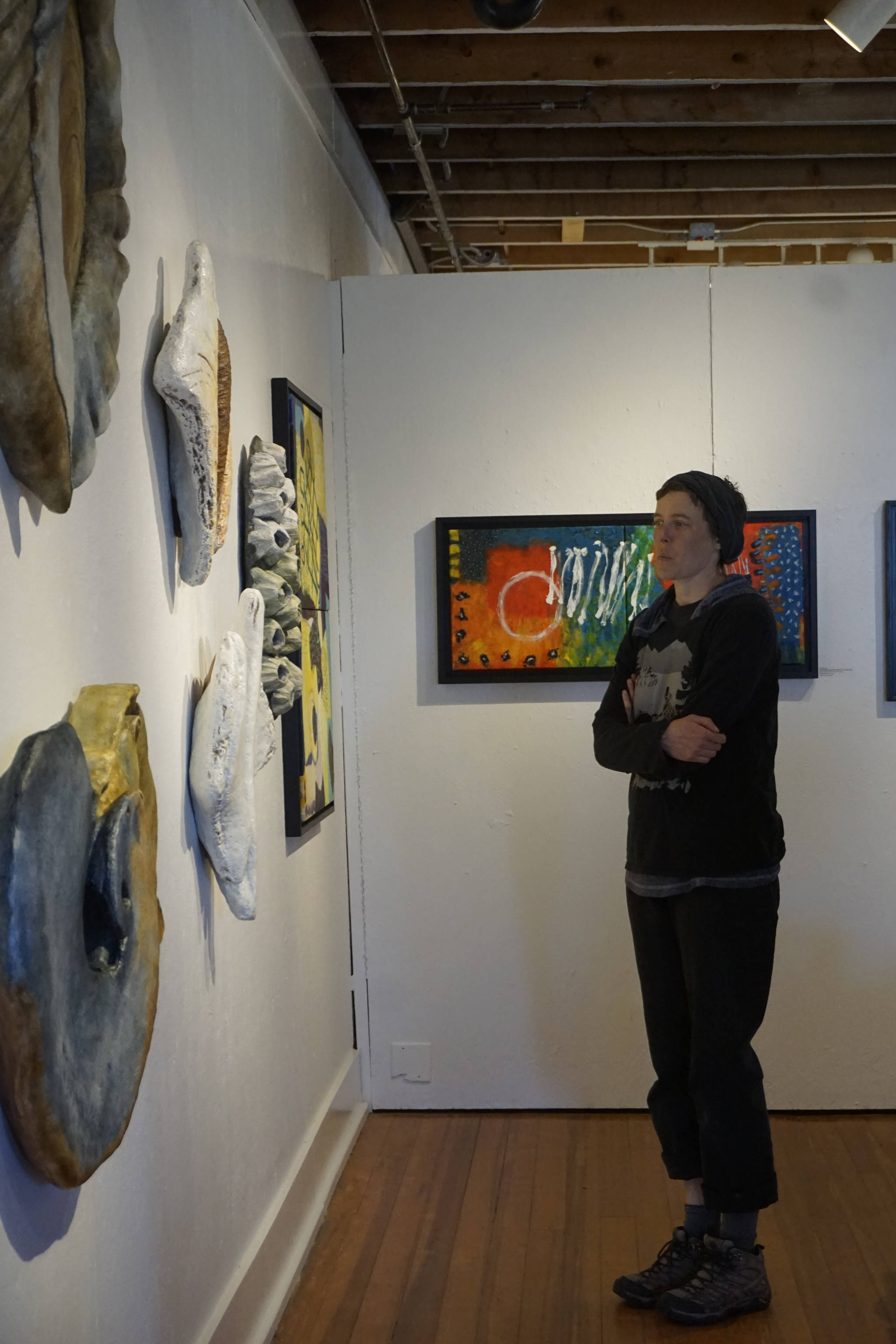At big minus tides when the sea retreats and intertidal life become visible, Kachemak Bay beaches turn into transient treasure chests. Heads down, clusters of citizen scientists poke among rocks, searching for chitons and anemones and sea stars. Objects inches long or less bear the scrutiny of flashy diamonds in a jewelry shop.
In her show this June at Bunnell Street Arts Center, Homer artist Melisse Reichman has considered the beauty of tiny animals and expanded them as works of art 10 times or larger in scale. Reichman shows her sculptures in a two-person show with Graham Dane’s painting.
“This stuff just calls to me. It’s like the treasure hunt of the century to find these things,” Reichman said in her artist talk last Friday, June 1, at her show’s opening. “You pull the kelp away and these things are living there. It’s a teeny teeny taste of what’s out there,” she said of her show.
A Homer resident for eight years, Reichman brings 35 years of experience as a natural history model maker with firms in California, Arizona and Missouri. Even before she came to Homer, Dixon Studios of Tucson, Arizona, hired her to do a sculpture of a boy looking for gull eggs that is at the Alaska Islands and Ocean Visitor Center.
“I had no idea there was a place called Homer,” she said in a phone interview on Monday, June 4. ” I had no idea about that when I was hired to do that job.”
She later came to Homer to do some more work at Islands and Oceans on some natural history pieces. With her husband, Dave Eckwert, she later visited a few times. Some friends from St. Louis, Josh and Debbie Tobin, had moved to Homer and kept urging them to move here — even sending them job notices. Eventually Reichman and Eckwert came and stayed.
Born in St. Louis, Reichman studied art and biology at the University of Colorado, Boulder. Those passions merged in her work creating natural history models. She’s developed a technique using carved foam that’s encased in thin layers of cement. Reichman uses pink or blue insulation foam, though she prefers pink board.
“In Spenard’s (Builder Supply) they’re like, ‘It’s the same thing, lady. The R value is the same.’ It doesn’t carve the same,” she said in her artist talk.
Her technique becomes both subtractive — carving foam — and additive — adding cement. For color she adds cement stain. In some pieces she tried a new media for her, encaustic wax and paint.
“I started playing with it. I started right on a piece and said, ‘This is kind of working,’” she said.
While this is her first gallery wide exhibit, Reichman has had pieces in Bunnell’s 10×10 show. She also won two city of Homer 1-percent for art commissions, “A Soulful Eye” at the End of the Road Park and hanging sculptures of a moose, bear and marine creatures at the West Pioneer Avenue public restrooms. All have survived Homer’s tough winters.
“I’ve put together a concoction of cement that makes it pretty durable,” she said. “I can spread it pretty thin and still have it be really sturdy. I can make a pancake out of this that’s really, really thin and not breakable. It’s sort of a thing I invented myself.”
As a small woman, the process allows her to make large sculptures of about 20 pounds or less that can be moved around easily and hung on walls. Her biggest piece in the Bunnell show, “Pocket Pebble,” took two people to move and is big enough to sit on. For that one she used a block of foam collected in a marine debris clean-up project where artists and students turned debris into art.
“The big Styrofoam blocks weren’t usable so I took them to my studio and have encased this marine debris so it won’t get back into the landfill or the oceans,” she said.
In her Bunnell show, Reichman said she seeks to go beyond a natural history exhibit.
“I have done exact models of things,” she said. “This is very liberating to get away from that exact representation and get more interpretive in the form and the color and the textures – just the juxtaposition.”
She starts her pieces by photographing intertidal life and cropping and blowing up the images.
“The forms are sculptures to me. They’re living beings, but to me they are not only that, they’re just wow, look at this sculpture,” she said in her artist talk. “Who the hell designed this?”
Enlarging the scale of tiny animals reveals the aesthetic forms of the animals. A sculpture of a lined chiton a foot long shows the delicate swirls of its back, the texture of its bony plates. A cluster of tube worms looks like an abstract sculpture.
Reichman said she thought of her show as an experiment.
“Now I’m just looking at them larger and thinking ‘Will they still have that charm, that enticing beauty, that intimate, oh wow, if they change scale?” she said. “For me they do. … I fall so in love with it (the intertidal life) I want to get to know it more. The way to get to know it more is through sculpting.”
A former jewelry maker, Reichman compares intertidal life to her bracelets and earrings.
”It really helps me to understand what is so exquisite about them,” she said of the tiny sea creatures. “When they’re little they’re very charm like, very gem like. By learning these forms, I crawl around their surfaces with my hands. They’re so beautiful.”
Reach Michael Armstrong a marmstrong@homernews.com.


